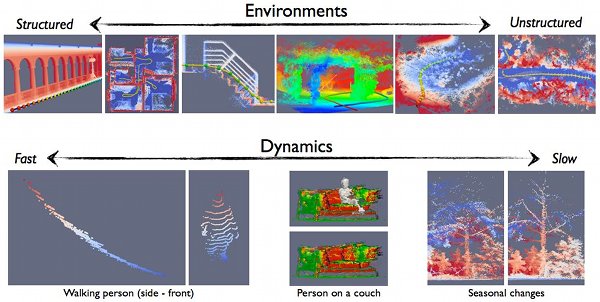Challenging data sets for point cloud registration algorithms
Those data sets were published in:
F. Pomerleau, M. Liu, F. Colas, and R. Siegwart, Challenging data sets for point cloud registration algorithms, International Journal of Robotic Research, vol. 31, no. 14, pp. 1705–1711, Dec. 2012. bibtex, Publisher Link
Overview
This group of datasets was recorded with the aim to test point cloud registration algorithms in specific environments and conditions. Special care is taken regarding the precision of the "ground truth" positions of the scanner, which is in the millimeter range, using a theodolite. Some examples of the recorded environments can be seen bellow.
Where do I start?
You first need to determine which data suit your needs.
For that, pick up a dataset in the table below based on your requirements.
If you are not sure, we suggest to start with structured datasets as they are easier to visualize.
There, you will be able to have a look at different screenshots and pictures of the scene, which will help you to understand better the abstract point clouds.
Then, go to the section Downloads → Visualization Files and download the file globalMap.vtk.
To easily view this type of file, we suggest to use Paraview (http://www.paraview.org/) because it is freely available for Windows, Mac and Ubuntu users and it is well supported by Kitware.
Another advantage is that Paraview can handle large point clouds with information on points faster than Matlab.
Once you have selected the datasets you need, you can download files in local reference frame if you want to test registration algorithms and compare your result with pose_scanner_leica.csv, which contains the ground truth information. If you are doing environment modeling, meshing, etc., you can directly download point clouds in global coordinates.
Data sets
| Data set names | Situation | Environments | Dynamics |
|---|---|---|---|
| Apartment | Indoors | Structured | Furnitures moved in between scans |
| ETH Hauptgebaude | Indoors | Structured with repetitive elements | Walking persons |
| Stairs | Mixed | Structured with large variations in scanned volumes | None |
| Mountain plain | Outdoors | Semi-structured with low vertical constrains | None |
| Gazebo in summer | Outdoors | Semi-structured (sparse vegetation) | Seasonal changes (see winter) |
| Gazebo in winter | Outdoors | Semi-structured (sparse vegetation) | Seasonal changes (see summer) |
| Wood in summer | Outdoors | Unstructured (dense vegetation) | Seasonal changes (see autumn) |
| Wood in autumn | Outdoors | Unstructured (dense vegetation) | Seasonal changes (see summer) |
Dataset general characteristics
Sensors (complete description here):
- Laser: Hokuyo UTM-30LX
- IMU: Xsens MTi-G
- GPS: Xsens MTi-G
- Theodolite: Leica TS15
Provided information:
- Point clouds in scanner frame
- Point clouds in global frame
- Gravity vectors
- Magnetic north vectors
- GPS coordinates (poor)
- “Ground truth” pose of the scanner
- Contextual pictures
- Screenshots of the data
File formats (complete description here):
- rosbags: raw measurements
- csv with headers: point clouds
- csv with headers: complementary sensors
- jpeg: external view of the scenes
- vtk: point clouds in global frame
- vtk: complementary sensors associated to every pose
Other uses (using the provided point clouds in their global coordinates):
- 2D and 3D path planning
- 3D environment modeling
Permissions
You are hereby given permission to copy this data in electronic or hard-copy form for your own scientific use and to distribute it for use to colleagues within your research group. Inclusion of rendered images or video made from this data in a scholarly publication (printed or electronic) is also permitted.
Contact
For more information, don't hesitate to contact François Pomerleau

